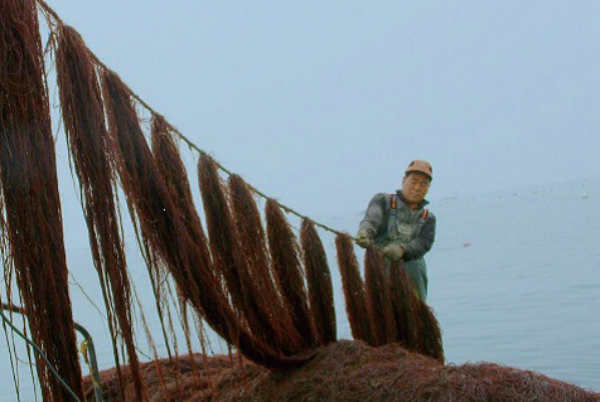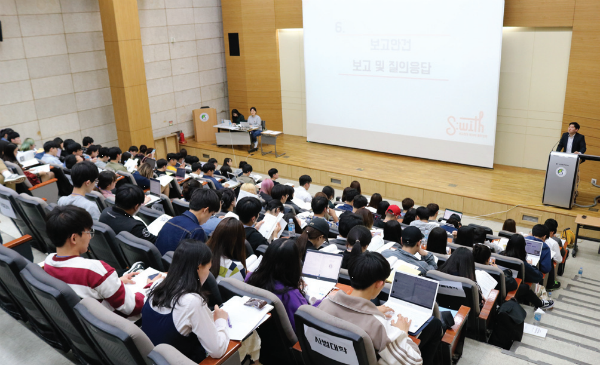SKKU Research Team Develops Nanoparticles to Enhance Drug Delivery Efficiency
A research team led by Professor Park Jae-hyung from the School of Chemical Engineering has developed a nanoparticle that widens blood vessels, which results in improving drug delivery efficiency. Several fatal diseases, such as cancer and cardiac disorders, bring about pathologic angiogenesis. Angiogenesis is a formation of new blood vessels with irregular and poorly constructed vascular walls from the existing vessels, which may cause an interruption in blood circulation of problematic parts. Intravenous injection, therefore, has made up only 10% of drug delivery efficiency so far, which was insufficient to cure diseases.
In order to solve this problem, the SKKU research team formulated nitric oxide-generating nanoparticles (NO-NPs) using nitric oxide which expands blood vessels in the body. NO-NPs are accumulated in target areas and release nitric oxide selectively under certain stimuli. When the team injected NO-NPs to animal models with cancer, the blood vessels in cancer tissues were widened and drug delivery efficiency was increased. These nanoparticles are accumulated and absorbed only in the cancer tissues. They do not react while circulating in blood vessels, but respond to a specific material in cells and release nitric oxide and the anticancer drug. Since the blood flow rate is increased only in the tumor areas, no side effects like low blood pressure and headaches are expected. Due to their limit of delivery efficiency and side effects, nanomedicines were hardly used to cure angiogenesis related diseases. The success of the SKKU research team, however, is expected to contribute to the advance of nanomedicine commercialization. “This research developed a drug delivery system for reconstructing the environment for nanoparticles to increase delivery efficiency by itself. It is anticipated that this technology will be possibly used to cure various other diseases related to angiogenesis,” said Professor Park. The research was published in Nano Letters, an authoritative journal in the field of nanotechnology, on April 11th.
SKKU Research Team Discovers the Secret of Red Seaweed Genome

A research team led by Professor Yoon Hwan-su from the Department of Biological Sciences discovered for the first time that red seaweed has an epigenetic control mechanism. The team used Gracilariopsis chorda for the research, which is an edible seaweed mainly distributed in Korea, Japan, and their adjacent waters. Through the observation, they found out the special genetic evolution pattern and genetic control mechanism of red seaweed. The research team has collaborated with another team led by Professor Hwang In-hwan from Pohang University of Science and Technology (POSTECH) and analyzed that the carbonic anhydrase gene of Gracilariopsis chorda has a higher efficiency than any other genes that had previously been discovered. Carbonic anhydrase is an enzyme that causes carbon dioxide to make carbon when reacted with water. Using this functional gene of Gracilariopsis chorda, they have been working on further research to construct a carbon dioxide removal system. Moreover, the joint study of Professor Yoon, with a team led by Professor Kwak Jong-Hwan from the School of Pharmacy at SKKU, analyzed the active ingredients of Gracilariopsis chorda which are efficient in relieving diabetes and arteriosclerosis; a patent regarding the research is currently pending. Professor Yoon Hwan-su said, “Genome information of Gracilariopsis chorda has been used directly or indirectly in various academic and industrial uses, and it will be used as a model for many further uses of marine biological genome information.”
The discovery is highly meaningful in that Gracilariopsis chorda is to be only the second red seaweed species whose entire genetic information has been discovered. Moreover, it has contributed to elevating the international status of Korea in the field of marine science. Likewise, for further discovery and utilization of the functional genes, it is important to discover the hidden genetic information of major marine biological resources. The research was published in Molecular Biology and Evolution, an authoritative journal in the field of Evolutionary biology, on April 11th.
Student Representatives Conference: Update on Implementation of S:with’s Pledges
On April 2nd, the General Student Representatives Conference for the first semester of 2018 was held both at the Humanities and Social Sciences Campus and the Natural Sciences Campus respectively at 7pm, in conjunction with the 50th student council, S:with. Held at the beginning of every semester, the General Student Representatives Conference consists of members of student councils of each department, college, and other students’ organizations, including the School Club Association and the student organization for preparing for graduation. The conference went on with the recapitulation of the previous conference, reporting of the student council for managing and implementing its pledges, voting on ratification bills, and a question and suggestion period for student representatives to the student council.
The General Student Representatives Conference on the Humanities and Social Sciences Campus was held at lecture room 33B101 of the Business School building, with 121 out of 186 enrolled members being present. At the conference, the 50th student council S:with reported the implementation of 18 of its pledges in total. Regarding its education pledges, it read through the minutes of the tuition committee meetings. In regards to its facility and welfare pledges, S:with reported on the installation of Gooddoc lockers with first aid kits, improvements of restrooms and women’s lounges, and a variety of welfare services during exam periods including the news that a shuttle bus will be operated during the I-Campus exams on Sunday, and the plan to extend the radiator operating time in the Student Center. Next, student representatives voted on four ratification agenda: the approval of central executives of the student council, the distribution of student union fees, budget planning, and the closing account. According to S:with, its budget will be used to repair the wooden stairs behind the 600th Anniversary Hall and the streetlight behind the Dasan Hall of Economics, to expand and improve rest areas on campus, and to host the festival. All four bills were approved with over an average of 85% in favor. Lastly, student representatives and the student media asked questions to the student council. There was a question about the installation of artificial grass. S:with replied that it discussed funding with the alumni association and is planning for the installation with the school’s management team in more detail.

In the meantime, the General Student Representatives Conference on the Natural Sciences Campus was held at lecture room 23219 of Engineering Building 1, with 55 out of 68 enrolled members being present. At the conference, S:with first read through the minutes of the tuition committee meetings, and each department of the student council reported the implementation of its pledges and plans to carry out the rest of the pledges. In regards to its facility and welfare pledges, S:with reported the improvement of men’s lounges and various cooperation events with an ophthalmic clinic, a cinema, Mobike, etc. Next, student representatives voted on three ratification agenda: the approval of central executives of the student council, the distribution of student fees, and budget planning. Although executives of the student council were approved, the distribution of student fees was rejected in which the student council proposed to reduce the basic distribution of student union fees to 14.5%. Some student representatives, however, argued that lowered basic distribution will have a huge impact on the college with a small number of students. Therefore, the second General Student Representatives Conference was held once more on April 9th to discuss the reintroduced distribution of student union fees, with 46 of 55 enrolled members being present. The bill was approved with 45 of the representatives in favor. In addition, S:with introduced its budget plan: to repair the stone steps in front of the NU Café, to repair damaged goods from the rental service, to hold open special lectures for students, and to host the festival. Lastly, student representatives and the student media asked questions to the student council. At the first conference, there was a question about the online community of SKKU, which was one of the main pledges of S:with. S:with answered that it is trying to create a sustainable community with useful information from alumni.
